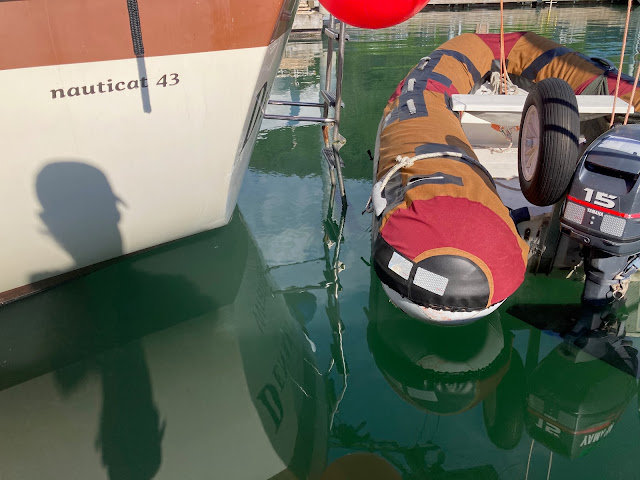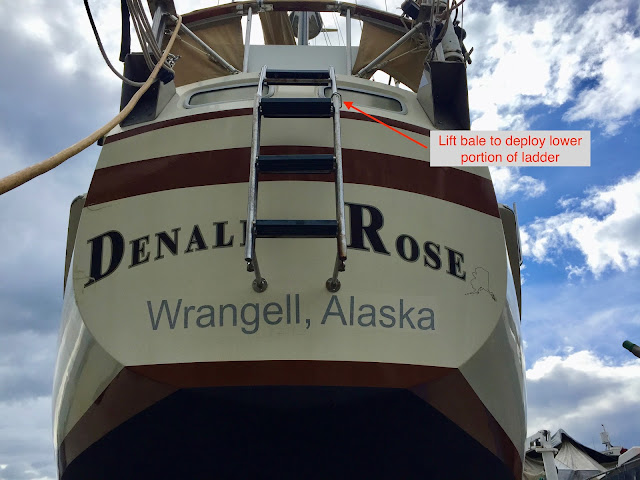This is another in the series of Stuff we have and use and do... (See right hand column =>)
It may not be of interest to many of you for various reasons. (Lucky you. So go count your blessings and read no further...)
This is more related to the higher latitudes we frequent, with the associated cooler waters... (Or for anyone who becomes separated from the boat while underweigh...)
We fully realize- and have personally experienced- regions of the world where one may never wish to get out of the water... This blurb is for those of us who must, for whatever reason(s).
We routinely examine the following questions when on our own boat:
- While at anchor:
- How do we get back aboard our vessel from another craft (e.g., SUP, kayak, dinghy, etc.)
- How about if we are in the water? (Intentionally or otherwise...)
- Our boat's freeboard is too high to pull ourselves back onto the boat.
- Are our ladders usable and always available?
- If not, are they readily deployable by someone in the water?
- When deployed, does a ladder extend far enough below the water surface to facilitate easy use? (If the first rung is at water level you need to try it before depending upon it...)
- How about if wearing diving gear?
- Or folks not in the best of shape, or slightly injured?
- What if someone in the water is injured? (But can still climb a ladder...)
- Retrieving an injured person who cannot rescue themselves from the water is a different topic.
- How about at the dock? (Any dock...)
- Just as you note the locations of fire extinguishers and escape routes when visiting another boat, you also take note of any boarding ladder locations, life rings, and fire extinguishers at all docks, right?
- No, or none existent? Then best make sure your own boat has provisions to readily get back aboard...
Our home port slip is too high above water level to easily pull ourselves onto. (Especially without getting a belly full of splinters, or road rash...)
Additionally, our harbor's ladders are a 200-300 yard swim for those moored near the ends of the floats. This is because there is only one ladder per fairway (Must be a legal/ insurance minimum?) And those ladders are round runged, center poled designs, so your numb, slippery feet-now bloodied after kicking off the thick layer of muscles- would try to slide off the ends of the short rungs, reaking havoc on your ankles and legs. But better than nothing...?
Therefore we do give some thought (and practice) to reboarding our boat from other floating objects- and of course the water. (Not to mention other tricky maneuvers- whether warranted or not...)
Speaking of basic: several boats ago, when I was much older and still semi-immortal, I had one of those collapsing rope ladders with hard rungs. I kept it hung over the side with a line hanging so I could yank it down into the water if needed. What a pain those are to climb, but again; better than nothing... perhaps...
Here is our very basic stern boarding ladder with 3 rungs underwater when deployed (unfolded so it extends below the water surface.) Note: Four underwater rungs might be better for SCUBA divers- and perhaps those of us with a higher than normal surface area to volume ratio...)
Note it is designed so it can still be used undeployed. (e.g., For accessing the dinghy, etc.)
Also note the sturdy stair treads thru-bolted to tabs welded to the stainless tubing rungs. These are much preferred to round tubing...
The [whiteish] trip-line that runs up from the wire bale (simple latch that holds the ladder in folded position, upper right, above) can be yanked from either side of the ladder by someone in the water. Pulling the trip line lifts the latch, resulting in gravity deployment of the swinging part of the ladder (the underwater portion.)
Note to selves: keep fingers, toes, noses, and any other dangly bits well clear of the ladder hinges- and noggins out of fall path- when deploying from the water... (i.e., Make sure everyone is off to either side of the ladder before deploying.
 |
Also notice this portable ladder has stand-offs that bear against the hull.Hint: Use crutch tips for this purpose. They are much sturdier and last much longer than the usual rubber caps you find in hardware stores. They also have a metal washer sandwiched in the thick foot so the tubing cannot punch through the rubber over time- tatooing the hull... (We find them in local hardware stores for ~$5/pair...) |
These are our simple methods of making sure we can always get out of the water in a hurry- even at the dock.
One final safety reminder we regale ourselves with often: Just as we treat the edge of the deck as we would a 500 foot cliff when underweigh, we always use any ladder as though we are climbing up or down from a 2nd story roof on a house (or the boat in the yard:)
Facing the ladder! (NOT with our back to it!)
Unless, of course, one covets one of these shirts: (Lessons learned? Time will tell...)The same applies for companionway ladders/ steep steps, etc. (For us anyway...)








